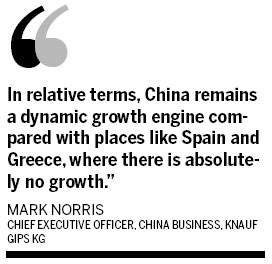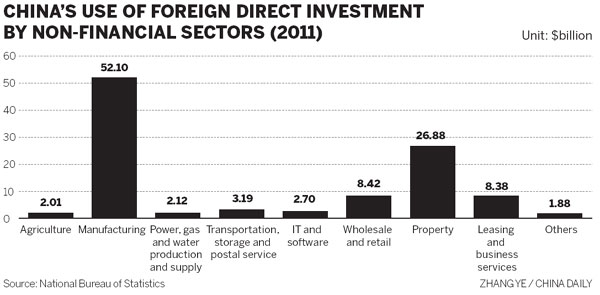Foreign firms bullish about economy
|
A woman demonstrating a heat-resistant material at a building materials fair in Shenyang, capital of Liaoning province. Many foreign companies are still bullish about China's property market and have continued to invest in both real estate and building materials. Liu Haiyang / For China Daily |
Germany looking more to China than Europe for overseas investment
Germany has always been the cornerstone of the European economy but Europe is not as important to Germany as it used to be.
For the first time China has become German companies' top foreign investment destination, totaling $1.36 billion by the end of last year, according to a survey by the Association of German Chambers of Industry and Commerce. The amount was more than the combined German investment in France, Spain and Italy.
The profound shift is visible in the case of Knauf Gips KG, a German-headquartered plasterboard manufacturer.
When asked what helped turn the family-owned workshop into the world's second-largest gypsum board maker, Mark Norris, the company's China chief executive officer, said one particular factor stands out - China.
After its entry into the Chinese market in the 1990s, Knauf built three plants in Beijing, Shanghai and Guangzhou. The initial investment soon gave Knauf a solid foothold in the country's dry-wall market.
Norris said he was quite bullish about the future and remained committed to continuing investment, despite decelerating economic growth in China, compounded by the European crisis and stagnation in the United States.
"In relative terms, China remains a dynamic growth engine compared with places like Spain and Greece, where there is absolutely no growth," he said.
"And people seem to forget that the market is so big, the demand for good quality is there.
"As we noticed over the past five years, a mid-to-upper class has emerged and the quality of life is increasing. People are prepared to pay for green building materials. Even though it's not comparable to the European or US standard, it is catching up quick."
While Knauf is poised to continue investing in the world's fastest-growing economy, its plans this year are set to be more reserved.
Knauf's ongoing project portfolio includes the completion of its largest plant in China in Taicang, Jiangsu province, a manufacturing base close to Shanghai. It will become the most advanced factory in the Asia-Pacific region that strives to stay carbon-neutral, according to the company.
But rather than expansion, Knauf will focus more on upgrading its existing plants. Starting from this year, Knauf is devoting millions of dollars to ensuring that all of its existing plants are purely steam-driven and no coal or heavy oil is used.
"If you look at the 12th Five-Year Plan (2011-15), you will notice that the previous one was much about quantity, growth and volume, whereas the current one is about quality, better living standards and a good environment," said Jan Kreibaum, president and CEO of Knauf Asia-Pacific. "It attaches importance to quality, where we exactly fit in.
"You can't have 20 coal plants with oil burners and say, 'yes, we are going green'. Chinese customers now do care that the green process is from start to finish," Kreibaum said.
Confident but rational, and putting quality before quantity - Knauf's China strategy this year is shared not just by other German companies but many European and US firms.
According to a poll conducted by the American Chamber of Commerce in Shanghai in February, the majority of US companies are bullish about China's economic outlook and will expand their investment this year.
According to Sarah Butler, managing director of consultancy Booz & Company's China division, for foreign firms, investing in China is no longer an option but a necessity.
"This reality is driven partly by the natural and inevitable saturation of their home markets as the Western economies mature and companies are driven by the need to continuously seek growth opportunities internationally."
Despite forecasts that China's economy will slow - which was verified by the latest year-on-year GDP growth of 8.1 percent in the first quarter - General Motors China is planning to double its sales volume to 5 million units over the next five years, said president and managing director Kevin Wale.
"It will still come between 7.5 to 9 percent of GDP growth, I believe. We will have a continuous and very strong presence here," he told China Daily.
GM has set aside $1 billion to $1.5 billion to support its China business, and will focus on renovating its current plants. For instance, the company just opened an extension to its plant in Qingdao and is extending another plant in Yantai.
"We will not consider major moves such as mergers and acquisitions any time soon," he said.
Jeff Kirwan, managing director of clothing retailer Gap Inc, said although the company is fairly new to the country, he still sees chances to do well.
Kirwan told China Daily that Gap plans to have 30 more stores, up from the current 15, and its presence will reach 10 cities by the 2012 fiscal year. Besides, China will be its largest growth vehicle in terms of both sales and investment.
"China is a competitive market and is becoming more so as more international retailers enter the marketplace. I foresee multiple brands coming under one company over the next five years," he said.
The downward adjustment of China's GDP growth target has failed to deter multinational corporations, as many see the opportunities to turn the current government goal to their advantage.
"From China's 12th Five-Year Plan, we see a clear strategic switch for China to be more focused on the quality of growth instead of speed. We think that is a right direction. In fact, we see more opportunities in that direction, especially in the fields of improved living standards, innovation of new materials and biotechnology," said Jiang Weiming, DSM's China president.
Headquartered in the Netherlands, the specialty chemical company has in the past five years aggressively entered life sciences, particularly food nutrition, which witnessed a 10-fold jump in sales.
DSM has developed vitamin and mineral mixtures to meet the needs of Chinese children suffering from anemia. Its net sales in China increased 30 percent year-on-year to $2 billion in 2011.
Jiang said DSM will continue its strong focus on China and expects to more than double its China sales to more than $3 billion by 2015, supported by planned investment of $1 billion.
But it will shift from "an intensive portfolio to maximizing sustainable and profitable growth, with concentrated efforts to meet high-end demands for health and nutrition in China", Jiang said.
Only 8.5 percent of surveyed US companies in the AmCham survey are set to build new offices in China in 2012, whereas the majority would "evaluate" the pros and cons before making such a move.
This is a trend which will be sustained over the next decade or so, said Butler. Companies need to make the necessary investments to sustain their presence and competition over time.
According to Dan Steinbock, research director of international business at the India, China and America Institute in the US, it is only reasonable for European and US companies to shift from "going for presence" to "going for quality".
"When foreign companies established their operations in the mainland, China was still a low-cost nation. Now several regions are moving toward innovation-based competition and, over time, relatively poorer cities and provinces will follow. If foreign companies want to compete successfully in China's rapidly changing environment, they cannot remain complacent."
Maturing market
|
Despite forecasts that China's economy will slow, seemingly vindicated by the latest year-on-year gross domestic product growth of 8.1 percent in the first quarter, international companies are planning to further involve their businesses in the country's economy. Gao Yuwen / For China Daily |
As the China market continues to develop, companies increasingly are treating it as a mature, fiercely competitive market with all the attendant benefits and challenges of such a status.
First, China has become a growth engine for most multinationals, so that to advance beyond a merely supportive role, a growing number of them see the necessity to introduce key technologies, or build research and development centers in the country.
Dow Chemical Co established its flagship 100,000 square meter innovation center in Shanghai in 2009, which now has more than 500 scientists and researchers working in 84 world-class laboratories.
According to Peter Sykes, president of Dow China, the lab has facilitated Dow's overall research and development globally and helped China to become its second-largest international market. In March, it opened a new center in Chengdu to explore more investment and innovation opportunities.
Likewise, General Motors signed an agreement with SAIC Motor Corp late last year to jointly develop electric vehicles in China. Tim Lee, president of GM's international operations, told China Daily that the two sides want the partnership to serve as the global test ground for new energy cars over the next five years.
The cooperation will leverage GM's expertise in electric vehicle development and global know-how and the techniques will be carried out in China.
In an earlier interview with China Daily, DSM's global CEO Feike Sijbesma said the company's decision to establish a global R&D center in Shanghai was a result of his "four-phase China" theory.
"It is a country with four different development phases. The first phase was to show the world how big a market it is. The second phase was flexing its muscles to become a productive manufacturer and a strong competitor. In the third phase, China was home to the industrial bases of Western companies," he said.
Now the fourth phase is coming with the Chinese realizing they can no longer depend on low-cost manufacturing and need to create a base for innovation and global brands.
Butler from Booz agreed. As China is climbing the global value chain, companies are no longer treating China as a "market to tap into" or a "manufacturing base", but rather placing an increasing portfolio of capabilities there.
According to Norris from Knauf, his company started to operate an innovation center in Taicang this year. "We have six senior research fellows up to now and we expect the team to have some 20 people when fully established."
These scientists mostly have to be Chinese people with knowledge of cutting-edge German technology, Norris noted.
"We need to come up with products that meet the demand of the locals here but you really can't expect German scientists to understand the environment or living conditions here in China".
What Norris said brings up a related issue for multinationals' China businesses: the "in China for China" trend.
In the AmCham survey, a maturing China market is forcing companies to target their product development toward China, with 71 percent responding that they have and also plan to sell and support products and services uniquely designed for the Chinese market.
Trumpf, the world's largest maker of laser cutting machines, has designed a special cutting machine to meet Chinese customers' needs.
"We are not producing in China to be less expensive, or to export to other parts of the world," said Nicola Leibinger-Kammueller, the company's chief executive officer.
"We are producing for the Chinese market."
Also a German family-owned enterprise, Trumpf took a similar approach to Knauf - it runs a plant in Taicang and is currently overhauling the factory to double its production capacity.
Her company also lowered its forecast for the Chinese market's growth rate from 100 percent in 2011 to a moderate 15 to 20 percent this year.
"We want a steady growth that focuses on the premium market, where demand for quality in China is absolutely rising."
And this trend may be good for another reason, according to Steve Ganster, managing director of Technomic Asia, a market entry consultancy.
"Given the challenges that will emerge in 2012, service companies will be in a good position to help their clients navigate the increased complexities, uncertainties and inevitable difficulties, as companies adjust their strategies, organizations and resources to align with a more dynamic economic environment," he said.
"The 'in China for China' trend is here to stay and service firms need to reshape their own priorities to accommodate this critical shift."
Challenges ahead

While foreign players have long wrestled with human resource constraints and intellectual property rights protection issues, they now rate rising costs and geographic diversity as emerging concerns.
More than nine in 10 companies surveyed by AmCham said rising costs hinder their business, with two-thirds saying price pressures are becoming more severe.
"Nobody is immune to the rising costs of labor, raw material and energy," Norris said. But as every enterprise has to tackle these issues, Norris sees opportunities.
Knauf will introduce one of its hit products, spray plaster, to China in 2012. The building method is up to three times faster than manual plastering, enabling a three-man team to complete up to 150 square meters of high-quality plasterwork every day. And by applying such practices, Knauf helps his clients save labor costs.
It is the same story with Trumpf. Although its products are generally two to three times more expensive than those from its domestic counterparts, Leibinger-Kammueller said their machines offer great advantages.
"Ten years ago, labor was very cheap in China, but not any more. As our Chinese customers also face soaring labor costs, they gradually turn to our machinery to save labor," she said.
Companies cite China's vast geographic diversity as another challenge.
And this has led multinationals to cautiously expand to inland cities, not for the sake of expansion, but out of various considerations.
"In terms of geographic coverage, the Chinese market is huge. Our customers always require a rapid and effective response to fulfill their critical demands. It's quite challenging for us to move our products in an efficient way from our manufacturing sites in the coastal areas to customers across China," Sykes from Dow said.
In order to cope with this, Dow pays close attention to the supply chain, distribution, and logistics capabilities. It has invested $200 million in a terminal and logistics center and a transactional processing service center in Tianjin.
Knauf is also considering heading west but the plan is still under evaluation. Such a move could help the company cut its freight costs by up to 25 percent..
While reducing costs is one concern, Kirwan from Gap has his own reasoning.
"In the US, when we are doing particularly well in one area and not so well in another, we are able make adjustments accordingly. But here we found it a little bit more difficult in China, where each key area and city has its unique circumstances," he said.
The company is steadily expanding so that it can learn more about how to cope with situations, he added.
According to Steinbock, companies must adapt to local needs to remain relevant in China. Most importantly, they must learn to think in terms of China's diversity, which will be an increasing reality.
There is also increased competition. The AmCham study showed most respondents identify Chinese private companies, followed by other foreign firms, as the source of the largest surge in competition.
Regarding regulation, companies will be held to an increasingly mature set of standards in realms such as food safety, workforce protection and manufacturing safety, said Butler.
"We believe the disciplining effect brought on by the maturation of the market is overall positive for Western players but may pose short-term challenges."
Evolving agenda
And companies noticed an interesting phenomenon - the evolving attitude toward foreign companies from local governments.
In the past, governments welcomed any foreign investors who could push up local GDP and raise the employment rate. Now they tend to be more "selective and picky" in terms of who to get to invest.
Wale from General Motors said a particular city will welcome your investment if what you are doing happens to coincide with its strategic layout.
In the case of General Motors, some local governments would like to utilize its presence to either reform the overall industrial sector or to catch up in areas such as safety regulations and emissions.
The one thing Norris found is that government officials speak about "sustainability" all the time, which was a rare occurrence even three years ago.
"When we were looking west, we found some great zones. But the officials in these places would turn down our requests because they found us hard to fit into those parks that are designed as either a pharmaceutical zone or an automobile zone," he said.
And the governments are now looking for role models to stay energy-efficient. "We were driven and challenged by the Taicang government to hit this level of green and sustainability. This is rare," he said.
Steinbock believed that local governments should focus on attracting only appropriate foreign investment that supports their overall growth policies. In turn, foreign multinationals should focus on appropriate localities that best serve their strategies.
"Let's compare this with the US market. With more than 310 million people, the US has some 50 states, which have grown increasingly specialized focusing on different comparative advantages.
"China is in a different stage of development, but the same process of differentiation has begun on the mainland as well. Being selective and picky is a good thing."
hewei@chinadaily.com.cn

(China Daily 05/07/2012 page13)
















